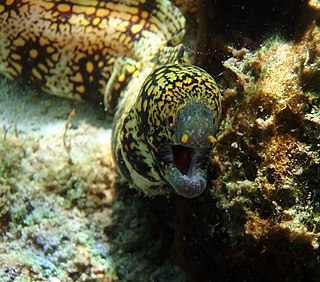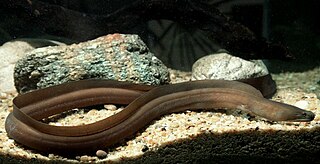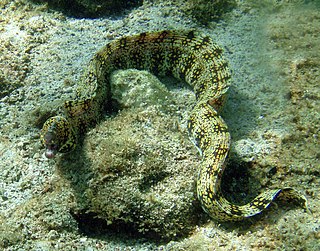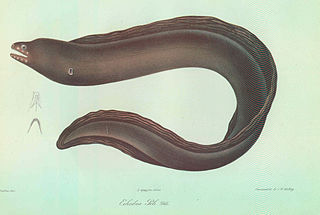
Moray eels, or Muraenidae, are a family of eels whose members are found worldwide. There are approximately 200 species in 15 genera which are almost exclusively marine, but several species are regularly seen in brackish water, and a few are found in fresh water.

Echidna is a genus of moray eels in the family Muraenidae.

The Kidako moray is a species of marine fish in the family Muraenidae. It inhabits coral reefs or lagoons and could be found in tropical and subtropical seas near Taiwan, Japan, and Australia. The species is diurnal, which means it is more active in the daytime than the nighttime. It is also piscivorous: it consumes fish, octopus, and squid. Other than the Kidako moray, there are about 200 species of moray eels in the Muraenidae family. The Kidako moray would not attack humans unless they are provoked. However, due to the menacing looks of the Kidako moray and moray eels in general, they are feared by divers and snorkelers.

Monopenchelys acuta, the redface moray or redface eel, is a species of saltwater eel, the only member of the genus Monopenchelys of the Muraenidae family. It is found in the Atlantic, the eastern Pacific, and the western Indian Ocean. Its length is up to 209 mm.

Strophidon is a genus of eels in the family Muraenidae. The genus has a wide distribution throughout the Pacific and Indian Oceans where they mostly inhabit the benthic zone.

The zebra moray is a species of marine fish in the family Muraenidae. It is the only member of the genus Gymnomuraena, though it sometimes has been included in Echidna instead.

The California moray is a moray eel of the family Muraenidae, found in the eastern Pacific from just north of Santa Barbara to Santa Maria Bay in Baja California. They are the only species of moray eel found off California, and one of the few examples of a subtropical moray. They typically occupy boulder or cobble habitats up to 40 m in depth. They can attain lengths of about 5 ft (1.52 m) and are believed to live for upwards of 22–26 years. Like other morays, they have no pelvic or pectoral fins or gill covers.

The yellow-edged moray, also known as yellow-margin(ed) moray, leopard moray, and speckled moray, is a moray eel of the family Muraenidae, found in the Indo-Pacific Oceans at depths to 150 m (500 ft).

The barred moray, also known as the banded moray, the dark-banded eel, the girdled moray, the girdled reef eel, the many banded moray eel, the ringed moray, the ringed reef moray, the striped moray and the zebra eel,) is a moray eel of the family Muraenidae. It was described by John Richardson in 1845, originally under the genus Muraena. It is a marine, tropical eel which is known from the Indo-Pacific, including the Red Sea, East Africa, the Hawaiian Islands, the Marquesan Islands, the Tuamotus Islands, the Ryukyu Islands, and the Great Barrier Reef. It dwells at a depth range of 2 to 20 metres, and leads a benthic lifestyle in reefs and shallow lagoons. Males can reach a maximum total length of 72.3 centimetres (28.5 in).

The snowflake moray, also known as the clouded moray among many vernacular names, is a species of marine eel of the family Muraenidae. It has blunt teeth ideal for its diet of crustaceans, a trait it shares with the zebra moray.
Echidna delicatula, the mottled moray, also known as the fine-speckled moray, is a moray eel. It was described by Johann Jakob Kaup in 1856, originally under the genus Poecilophis. It is a marine, tropical eel which is known from the Indo-Pacific, including Sri Lanka, Samoa, and Japan. It inhabits coral reefs. It can reach a maximum total length of 65 centimetres (26 in).
Echidna leucotaenia, the whiteface moray, also known as the white-banded moray eel, is a moray eel. It was described by Schultz in 1943. It is a tropical, marine and freshwater eel which is known from the Indo-Pacific, including East Africa, the Line Islands, the Tuamotu Islands, and Johnston Island. It dwells at a depth range of 0 to 24 metres, and leads a benthic lifestyle in reefs. Males can reach a maximum total length of 75 centimetres (30 in).

Echidna peli is a moray eel found in the eastern Atlantic Ocean. It was first named by Johann Jakob Kaup in 1856, and is commonly known as the pebbletooth moray.

The whitemargin moray or the white-edged moray, Gymnothorax albimarginatus, is a species of marine fish in the family Muraenidae.

The blackcheek moray eel or masked moray is a species of marine fish in the family Muraenidae.

The greyface moray eel, also called the freckled moray, slender moray, or white-eyed moray, Gymnothorax thyrsoideus, is a species of marine fish in the family Muraenidae.

The barred-fin moray or bar-tail moray is a species of marine fish in the family Muraenidae.
The Flores mud moray is an eel in the family Muraenidae. It was described by John E. McCosker and John Ernest Randall in 2008. It is a tropical, marine eel which is known from Indonesia, in the western Pacific Ocean. It is known to dwell at a depth range of 3–4 m. Males can reach a maximum total length of 29.9 cm.
The black body moray is an eel in the family Muraenidae. It was described by Loh Kar-Hoe, Shao Kwang-Tsao, and Chen Hong-Ming in 2011. It is a tropical, marine eel which is known from southeastern Taiwan, off Changbin, Taitung to Shihtiping, Hualien City and in the Pacific Ocean. Males are known to reach a maximum total length of 49.6 cm, while females are known to reach a maximum of 50.4 cm.
The Shao's moray is an eel in the family Muraenidae. It is a marine, temperate-water eel known from Taiwan, in the northwest Pacific Ocean. Males are known to reach a maximum total length of 60.8 cm.















